Mastering Two-Man Paddle Boarding: Techniques and Safety


Intro
Paddle boarding has become a prominent activity for those inclined towards adventure and fitness alike. When two people hop on a paddle board together, the experience transcends into a unique dynamic that combines teamwork, strategy, and a mutual love for the water. This article seeks to uncover the multiple dimensions of two-man paddle boarding—its techniques, the essential gear, safety practices, and the social interactions that lend charm to this outdoor pastime.
In the sections that follow, we will dive into gear essentials. Knowing what's best can set the stage for a successful outing. We'll explore techniques tailored for both beginners and seasoned paddlers. Each subsections aims to equip readers with valuable insights that enhance both skill and enjoyment on the water. The rhythmic motion of paddling becomes more efficient and enjoyable when practiced together, transforming what could be a mundane task into a dance across the waves.
Let’s commence by discussing gear essentials, laying the groundwork for an enhanced paddling experience.
Intro to Two-Man Paddle Boarding
Two-man paddle boarding, or tandem paddle boarding, is more than just a recreational activity; it’s a way to create shared experiences on the water. This sport grows in popularity every year, enticing both novices and seasoned enthusiasts. As the age-old adage goes, "two's company, three's a crowd" — and indeed, there’s something special about gliding over waves with a companion, sharing both the challenges and the joys of the journey. The beauty of tandem paddle boarding lies not only in the exercise or the scenic views but also in the collaboration and connection fostered between partners.
In this article, we’ll explore the intricacies of two-man paddle boarding, covering essential aspects such as techniques, equipment, and safety. We’ll view how paddle boarding with a partner enhances the experience, including greater stability, shared learning, and improved safety through teamwork.
Defining Two-Man Paddle Boarding
What exactly constitutes two-man paddle boarding? At its core, this activity involves two individuals using a paddle board designed to accommodate them both, propelling themselves forward across various water bodies. This setup allows for unique dynamics, different from solo paddling. While one person can certainly control the movement, having a second paddler brings new dimensions of balance, coordination, and pace. Think of it as dancing on water where both partners need to be attuned to each other's movements to make the most out of the experience. This activity can be enjoyable for friends, family, or couples looking to bond in a relaxed yet thrilling way.
Historical Context and Evolution
The roots of paddle boarding can be traced back to ancient Polynesian cultures, where early forms of the sport served as not just a means of transport but also as a way to fish and compete. As time rolled along, the traditional stand-up paddle boarding began evolving into various forms, including two-man setups.
Tandem boards gained momentum in the 20th century, particularly in the surfing communities of California, where individuals sought out new ways to enjoy the ocean’s embrace. By marrying the principles of surfing with the simplicity of paddle boarding, this evolution transformed a solo sport into a shared adventure. Nowadays, it’s common to see pairs navigating lakes, rivers, and oceans together, enjoying everything nature has to offer.
"The real magic happens when the harmony between paddlers comes into play, creating an experience that elevates the simplest outing into a cherished memory."
Throughout the years, paddle boarding gear has advanced significantly, allowing for improved design tailored toward tandem experiences. Inflatable boards and more stable hardshell options are now widely available, making this sport accessible to a broader audience. Now, with this rich history in mind, let's delve deeper into the multifaceted dimensions of two-man paddle boarding.
Benefits of Paddle Boarding in Pairs
Paddle boarding is not just an individual endeavor; it becomes a shared experience that magnifies enjoyment and utility when done in pairs. In this section, we will unravel the multifaceted benefits of paddle boarding as a duo. From enhancing stability to fostering camaraderie, the practice solicits both physical and emotional engagement. Understanding these advantages underscores why two-man paddle boarding has become a favored activity among many enthusiasts.
Enhanced Stability and Control
When it comes to two-man paddle boarding, stability stands tall as one of the primary perks. Essentially, having another person on board naturally distributes the weight across the paddle board more effectively. This equal weight distribution translates into greater balance, making it easier to navigate choppy waters or maintain position during gentle swells. A lone paddler might find a single wave tossing them around like a rag doll. In contrast, two paddlers can counterbalance each other, minimizing the risk of tipping and allowing for a more leisurely experience on the water.
Moreover, coordinated paddling tends to help alleviate individual strain, as both paddlers can adopt complementary strokes. When both people are in sync, it not only enhances stability but also, the collective control over steering and direction becomes markedly improved. This cooperation turns potentially strenuous paddling into a synchronized dance on the surf, where each movement flows smoothly into the next.
Social Interaction and Bonding
Paddle boarding in pairs fosters a sense of camaraderie that is seldom replicated in solo outings. It's one thing to glide across serene waters alone, but it’s a whole different ball game when laughter and conversation are intertwined with the paddling strokes. Having a paddle buddy can elevate the experience from a mere sport to a genuine social event!
Through this shared adventure, relationships can deepen as partners communicate not just verbally but also through their paddle movements. It’s a beautiful way to form connections, be it among friends, family, or even new acquaintances. As you navigate through calm lakes, or even more formidable waves, you forge memories that can last a lifetime. Whether you're shouting over the sound of splashing water or sharing peaceful moments watching the sunset, the social aspect turns a simple paddle outing into a cherished moment.
Shared Skills and Learning
A notable advantage of tandem paddle boarding is the opportunity for shared learning. Each individual brings a unique set of skills and experiences. Perhaps one partner has mastered the art of turning while the other is adept at reading the water conditions. This diversity creates a rich ground for skill-sharing and enhancement.
For instance, consider two novices paddling together; one might struggle with steering, while the other could offer insights learned from personal experiences. This exchange of ideas fosters an environment where both participants grow together. Moreover, tackling challenges side by side on the water can elevate the learning curve - making mistakes becomes less daunting when you can share them with somebody else, turning possible frustration into a moment of growth.
"Learning with others often makes the route to mastery shorter and filled with enjoyment."
In summary, paddle boarding in pairs is more than just a practical choice for stability and control; it enhances connections and enriches the learning experience for both paddlers. Engaging in this duo activity offers numerous dimensions that elevate both the sport itself and the relationships formed in the process.
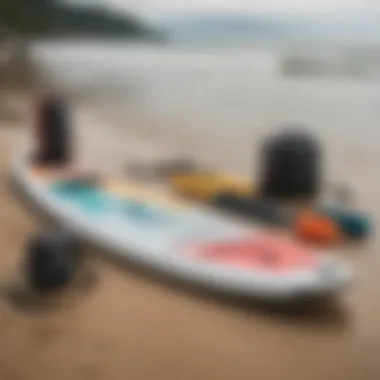
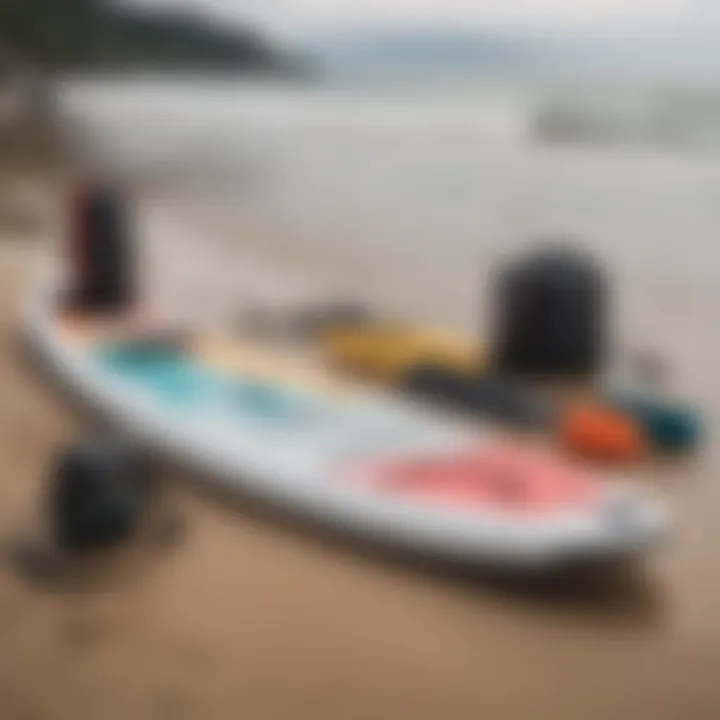
Selecting the Right Equipment
Choosing the right equipment is key in two-man paddle boarding. It can make the difference between a smooth glide on the water and a wobbly struggle. Having the proper board and paddles not only enhances performance but also contributes to the overall enjoyment of the experience. When both paddlers feel comfortable with their gear, it leads to better coordination and increased fun.
Types of Tandem Paddle Boards
Inflatable Boards
Inflatable paddle boards have jotted their name in the paddle boarding world for several reasons. One major aspect is their ease of transport and storage. Being lightweight and deflatable, they can fit in the trunk of a car or even a large backpack when rolled up. This key characteristic makes them a popular choice for those who travel often.
One unique feature of inflatable boards is their durable materials, usually military-grade PVC that stands up to rough usage, making them versatile for various water conditions. However, they might not offer the same rigidity or speed as other types, so it’s essential to consider what matters most in your experience. While they tend to absorb some impact and can handle small waves well, paddlers hoping for fast, race-like performance might lean elsewhere.
Hardshell Boards
Hardshell paddle boards present an entirely different experience. These boards are often made of fiberglass or epoxy, which gives them a rigid structure. Their firmness allows for better speed and stability which can be advantageous for drifting through open water or taking on waves in a controlled manner.
A key characteristic that sets hardshell boards apart is their streamlined shape, which typically cuts through the water with ease. Paddlers looking for agility and efficiency may find themselves drawn to these options. However, the downside lies in the challenges of transport and storage. They're heavier and bulkier, needing more room or a proper rack for transportation. Plus, once damaged, repairs can be pricier because of the material involved.
Choosing Paddles
Choosing the right paddle is crucial in tandem paddling. Ensure they are the right length for both paddlers. Generally, paddles should be a few inches taller than the tallest paddler. It’s also worth considering materials; lighter options like carbon fiber offer an ease of maneuvering, reducing fatigue during long stretches. The paddle's blade shape can also impact efficiency in the water. A wider blade means more power per stroke, which can synchronize well with the dynamics of a tandem setup.
Safety Gear and Accessories
Life Jackets
Life jackets are non-negotiable when paddle boarding. They keep you afloat in case you end up in the water, which can happen more often than one might expect. Modern life jackets come in various forms—options like inflatable types offer a sleek design without the bulk. The right life jacket not only provides safety but should also allow freedom of movement to enhance your paddling experience. They should fit snugly without being restrictive, gasping when you reach your arms up to paddle.
Leashes
Leashes are another vital piece of safety equipment when paddle boarding. They attach your paddle board to you, minimizing the risk of losing it if you fall off. The key feature here is the cord's elasticity; if it’s too long, it could potentially become a safety hazard, especially in rough waters. A good leash should keep your board within reach without causing any trip hazards. Investing in a robust leash can also withstand the forces of waves and currents, ensuring your paddle board won't drift away in a pinch.
Techniques for Tandem Paddling
Understanding the dynamics of two-man paddle boarding goes far beyond choosing the right gear or location; it heavily hinges on mastering the techniques of tandem paddling. When two paddlers are working in unison, the experience can transcend mere fun and become an intricate dance upon the water. Proper techniques greatly enhance stability, efficiency, and enjoyment, allowing paddlers to navigate challenges with confidence. Therefore, it’s crucial to delve into the specific elements that make tandem paddling both effective and enjoyable.
Coordinating Movements
Coordination is like the glue that holds tandem paddle boarding together. Without synchronizing movements, your efforts may end up feeling like two ships passing in the night. When paddlers coordinate their strokes, it creates a smooth and balanced motion, which helps maintain the board’s stability. This is especially important in choppy water or during abrupt directional changes.
To achieve this coordination, it’s beneficial to establish a rhythm. One paddler can count aloud or establish verbal cues, like saying “1, 2, stroke!” This encourages both paddlers to embrace a shared tempo, which also has the added benefit of making the experience more enjoyable. Moreover, synchronizing movements reduces excess strain on either paddler, promoting endurance over longer distances.
Effective Paddle Strokes
The paddle stroke is the engine of your paddle boarding experience. Each stroke must be deliberate and effective to maximize momentum. In tandem paddling, it’s vital that both paddlers use similar techniques. This means ensuring that both paddlers keep their paddles at the same angle and depth during a stroke.
- J-stroke: This is a versatile stroke that helps in maintaining a straight path. Both paddlers can employ this technique, which minimizes the need for correcting your course frequently.
- Forward stroke: Aim for a smooth entry and exit. Ideally, each stroke should glide through the water effortlessly. Even a slight misalignment can cause unnecessary drag.
To ensure efficiency, practicing the magazine technique is useful, where paddlers alternate frequently between strokes. This not only takes the load off any one person but also helps maintain a balanced board posture.
Navigating Different Water Conditions
Water conditions can change in the blink of an eye, and being attuned to these shifts is paramount for any duo on a paddle board. Factors like wind, wave height, and current can drastically influence your paddling experience. Knowing how to read water conditions can be the difference between a serene outing and a turbulent one.
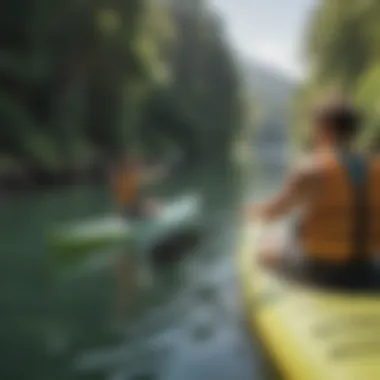
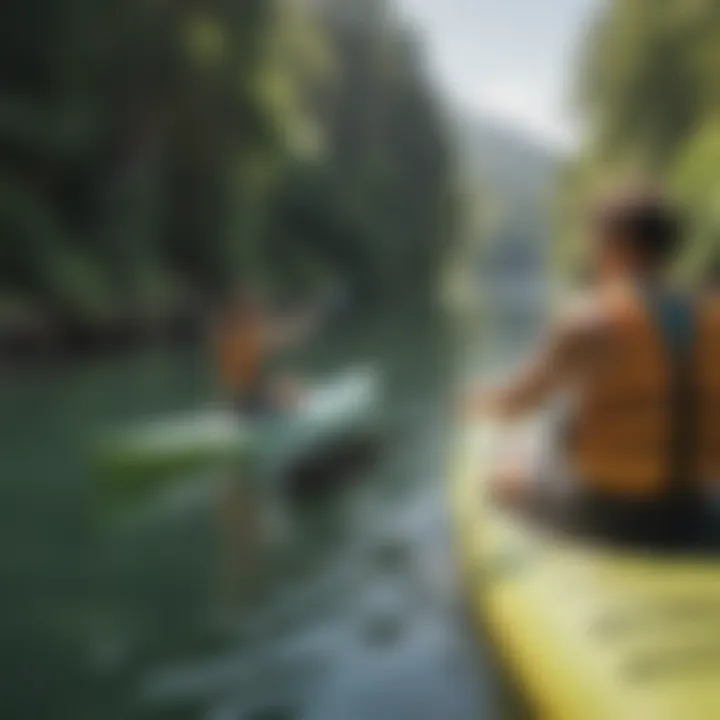
- Flat water: When the water is calm, a more relaxed paddling style works fine. Here, emphasis can be placed on refining techniques, such as stroke efficiency and coordination.
- Waves and chop: In rough conditions, maintaining a low center of gravity becomes imperative. This often means crouching slightly or adjusting your stance. Paddlers should focus on shorter, sharper strokes to maintain control.
- Currents and tides: Being aware of river flows or tidal movements can greatly affect how you paddle. It’s often advantageous for one person to lead during strong currents to improve navigation.
"Proper technique transforms challenges into opportunities for connection, making every outing memorable."
By understanding how to paddle effectively in various conditions, you’ll not only keep the two-man paddle board steady, but also enjoy the thrill that comes with adapting to nature’s whims. This coordination and technique brings enriches the experience for both paddlers, ensuring that the adventure remains as enjoyable as it is challenging.
Safety Considerations
When it comes to engaging in two-man paddle boarding, safety should never take a backseat. While the thrill of gliding over water can be exhilarating, understanding the vital elements of safety ensures that both paddlers can enjoy their experience without any unexpected hiccups. In this section, we'll peel back the layers on critical safety measures, why they're indispensable, and how they can lead to a more enjoyable outing on the water.
Understanding Water Hazards
Water bodies are seldom as serene as they may seem. Hidden dangers lurk beneath the surface, and it's crucial to identify these hazards beforehand. Some common water hazards include:
- Strong currents: Rivers and certain coastal areas may have significant current flows, posing a challenge, especially for inexperienced paddlers.
- Submerged obstacles: Rocks, tree branches, and sudden drops can easily capsize an unprepared tandem board.
- Weather changes: Sudden storms can brew up, and strong winds can turn calm waters into a turbulent ride quickly.
Knowing the type of water one will encounter is key. For example, paddling in a calm lake differs substantially from challenging ocean waves. As a tandem team, it’s prudent to scout the area prior to embarking on your adventure, including checking local weather forecasts and any alerts regarding water conditions.
Communication Strategies
Effective communication between partners is crucial for safe and enjoyable paddling. The dynamic nature of tandem paddle boarding means that you need to meld your strokes and movements smoothly to avoid mishaps. Here are a few strategies to enhance communication while you navigate the water together:
- Establish signals: Before hitting the water, discuss simple hand signals or verbal cues that both of you can use to indicate speed adjustments, turns, or any concerns regarding hazards ahead.
- Stay vocal: Regularly check in with each other to gauge comfort levels or fatigue. A simple "You good?" can go a long way in maintaining a positive atmosphere.
- Practice together: Just like rehearsing for a theatrical performance, practicing your movements and communication on dry land can build confidence and skill.
For instance:
"When I paddled with my pal last Summer, we devised a signal for overtaking other boards. Making things clear helped us dodge collisions like pros."
Emergency Preparedness
Despite our best efforts, unexpected situations can arise during paddle boarding. Being prepared can mean the difference between a mishap and a minor inconvenience. Here are essential steps for effective emergency preparedness:
- Plan Ahead: Before you set off, always create a float plan detailing your expected route, estimated time of return, and who will be expecting you back on shore.
- Carry Safety Gear: Having a whistle, first aid kit, and waterproof bag for essentials like food or a phone can save the day if troubles arise.
- Know Rescue Techniques: Knowledge of basic rescue techniques can empower you in case one of you falls overboard. Practice how to assist each other back onto the board in an emergency.
- Familiarize with Local Authorities: Understand who to contact in an emergency, such as lifeguards or rescue services in the area you’ll be paddling.
By giving due attention to these safety considerations, paddlers can not only mitigate risks but also enhance their teamwork and overall enjoyment while floating on the placid waters.
Environmental Awareness
Understanding and respecting the environment while paddle boarding is crucial for current and future generations of both paddlers and ocean creatures. Two-man paddle boarding, in particular, fosters a strong bond between participants, but also between them and the natural world. This section sheds light on how respecting aquatic ecosystems and adopting sustainable practices can enhance the experience of tandem paddlers.
Respecting Aquatic Ecosystems
The delicate balance of aquatic ecosystems should never be taken for granted. Paddlers should make it a priority to educate themselves about the local marine life, including plants, fish, and other creatures inhabiting the waters they explore.
- Awareness of Local Species: Knowing the specific species that inhabit your area encourages a deeper appreciation for the environment. It might be fascinating, for instance, to notice the unique wildlife during a leisurely paddle through mangroves or coastal estuaries.
- Protecting Natural Habitats: Anchor points and shoreline areas are often critical habitats for fish and birds. Avoiding plastic waste or foreign objects can significantly reduce damage to these habitats. Simple habits such as not disturbing nesting areas or using eco-friendly materials when repairing gear can make a world of a difference.
- Minimizing Noise Pollution: Paddle boarding is often a peaceful activity, taking one close to nature. Thus, it’s important for paddlers to keep noise to a minimum, allowing local wildlife to thrive undisturbed.
"Respecting the environment is not just about what we take from it, but also about what we leave behind."
Sustainable Practices
Embracing sustainable practices is essential for ensuring that the beauty of paddle boarding locations remains intact. The following strategies can help minimize the environmental footprint of tandem paddling adventures:
- Choose Eco-Friendly Gear: Look for paddle boards made from sustainable materials. Brands like Solid Paddleboards offer environmentally-conscious alternatives that do not compromise on performance.
- Leave No Trace: Follow the principles of Leave No Trace. Always carry out what you take in, be it food wrappers or water bottles. This not only maintains the aesthetic beauty of the landscape but also helps in preserving the environment for other users.
- Promote Awareness: Having discussions about environmental preservation with your paddling partner enriches the experience. Share tips and insights about local ocean conservation efforts or join local beach clean-up initiatives together.

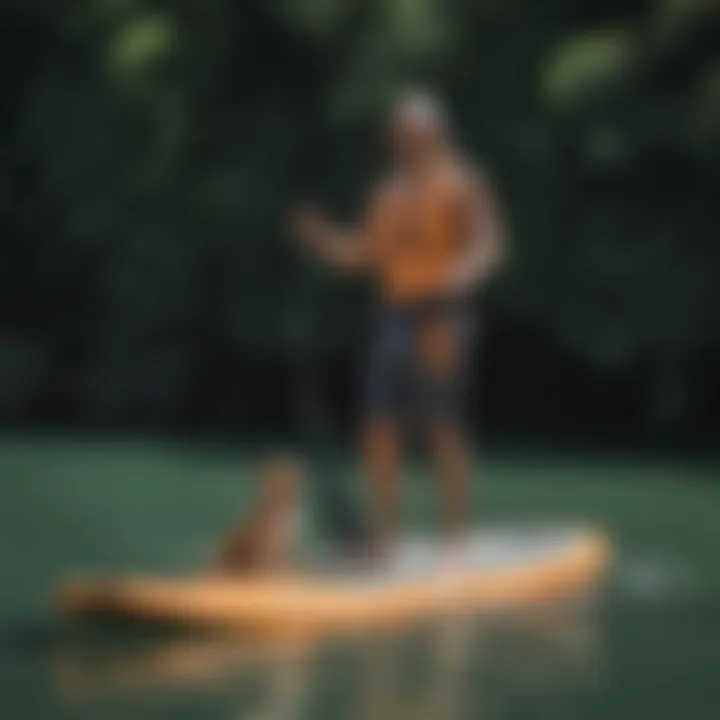
Taking these points to heart can lead to a much more enriching paddle boarding experience while simultaneously protecting the ecosystem. Being aware is just the first step; actively participating in sustainability can help elevate the sport we all love to new heights.
Exploring Scenic Locations for Tandem Paddle Boarding
When it comes to paddle boarding, where you choose to embark on your adventure can greatly influence the experience you’ll have. Each location offers a unique environment that not only enhances your enjoyment but also presents distinct challenges. Exploring scenic locations for tandem paddle boarding adds layers of thrill to the journey. It’s about more than just paddling; it’s about soaking in landscapes that can take your breath away, sharing experiences with a partner, and discovering hidden gems along the waterways.
A well-chosen setting can transform a simple outing into an unforgettable day. For instance, a serene lake surrounded by lush forests can provide a backdrop that calms the mind, while vibrant coastal waves can pump up the adrenaline for more spirited paddlers. The social aspect of finding picturesque locations also can't be overlooked. Often, popular spots attract fellow paddle board enthusiasts, presenting an opportunity to engage and exchange stories.
Exploring these gems can also be instrumental for novice paddlers who may need a bit of coddling when starting out. Less-choppy waters in quieter lakes or sheltered bays offer a comforting environment for learning and building confidence.
Top Destinations
- Lake Tahoe, California/Nevada
Famous for its crystal-clear waters and stunning mountain vistas, Lake Tahoe serves as an ideal setting. With calm mornings and gentle winds, tandem paddlers can glide across the lake, enjoying breathtaking views. Also, there are numerous beaches to explore once you get tired of paddling. - Florida Keys, Florida
Known for its brilliant coral reefs and clear, warm waters, the Florida Keys creates a colorful backdrop for paddle boarding. You can even paddle over vibrant marine life; it’s like swimming in an aquarium. It’s perfect for those looking for both beauty and adventure. - Maui, Hawaii
With its picture-perfect beaches and radiant sunsets, Maui offers something special. Whether you're paddling through tranquil bays or navigating the more exhilarating waves, the scenery is worth every stroke. It’s also a wonderful way to witness the local culture from a different perspective. - The Thames, London
For those in urban settings, paddling along the Thames offers a unique blend of city and nature. You can glide past iconic landmarks while keeping an eye out for swans and other wildlife that call the river home.
Local vs. International Spots
While international locations offer exotic experiences, local spots also present their own charm. Local paddle boarding destinations provide the comfort of familiarity. They allow you to delve deeper into your surrounding waters, often revealing hidden treasures that tourist spots lack. Places like local lakes, rivers, or coastal areas have their unique ecosystems, encouraging paddlers to appreciate their regional waters from a different angle.
However, international spots, like those in the Caribbean or Mediterranean, toss in a sprinkle of adventure and discovery. The allure of paddling in foreign waters can provide an enriching experience—the chance to encounter different marine life and varying climates. It’s like taking your paddle and immersing it in a completely new culture.
Finding the right balance between local and international locations can make for memorable tandem paddle boarding experiences. As paddlers, it’s essential to venture out and explore. Not only does it feed your soul, but the shared memories with your partner turn into cherished stories.
Ultimately, whether you're setting off on a familiar lake or an exotic beach, the spirit of adventure is what counts. Always keep your eyes peeled for new places to explore; sometimes, the best spots are closer than you think.
All in all, the choice of location plays a considerable role in making your paddle boarding experience much richer. As you plan your outings, keep your sights open on both local and international dimensions to truly savor what tandem paddling has to offer.
Community and Social Aspects
The world of two-man paddle boarding extends beyond just navigating the waters together; it embraces a vibrant community and rich social interactions that enrich the experience. The essence of this activity lies in its ability to forge connections—between paddlers, with nature, and within the broader paddle boarding community. When individuals decide to paddle in pairs, they are not just sharing a board; they are also sharing valuable experiences that make each outing memorable.
Joining Paddle Boarding Groups
Becoming a part of paddle boarding groups can transform a simple hobby into a passionate pursuit. These communities often provide a welcoming environment where both beginners and seasoned paddlers can learn from one another. By joining a group, you gain access to opportunities for socialization, skill improvement, and camaraderie.
- Local Meetups: Many cities have local paddle boarding meetups, offering an excellent way to connect with others who share your interest.
- Online Communities: In today's digital age, platforms like Reddit and Facebook host groups where paddlers can exchange tips, share routes, or even just boast about a recent adventure.
- Real-World Bonds: Joining a group can lead to lasting friendships. The shared goal of mastering tandem paddling often creates strong ties.
Participating in Events and Competitions
Engaging in paddle boarding events and competitions adds another layer of excitement to the experience. When paddlers come together for a common goal, it fosters a spirit of friendly competition and community support. Events such as races or exhibitions not only challenge abilities but also showcase the thrill of tandem paddling.
- Skill Development: Participating in events provides practical experience that enhances your paddling skills. You learn how to maneuver in a competitive setting and adjust your strategy on the fly.
- Networking Opportunities: Events attract participants from diverse backgrounds, opening doors for new friendships and collaborations within the sport.
- Creating Lasting Memories: Every event can serve as a story to tell—whether it's navigating rough waters, uniting as a team, or simply enjoying the ambiance. Every paddle brings unique takeaways.
"Being part of a community transforms solitary experiences into shared joys. You not only improve your skills but also create moments that last a lifetime."
In the vast realm of two-man paddle boarding, embracing community and social aspects not only enriches your personal experiences but elevates the entire sport. Whether through local groups or competitions, your paddle boarding adventure can be made all the more fulfilling through connection and shared experiences.
Ending
As we paddle towards the end of this exploration into two-man paddle boarding, it's essential to underscore the nuances and richness that this activity offers. Far beyond mere leisure, tandem paddle boarding is an avenue for enhancing stability on the water, fostering stronger connections between partners, and unlocking opportunities for joy and adventure some wouldn’t find solo. The significance of honing skills together, syncing movements, and developing a shared strategy can transform a day on the water into a memorable experience.
Recap of Key Insights
Let’s take a moment to summarize the fundamental insights gleaned throughout our discussion:
- Enhanced Stability and Control: With two people on the board, your ability to navigate rough waters improves significantly. Each partner can counterbalance the other's movements, leading to a more stable ride.
- Social Interaction: Sharing the board fosters camaraderie and deepens relationships. Whether it's friends, family, or new acquaintances, there is a unique bond formed through shared challenges and triumphs on the water.
- Technique Development: Learning to paddle together requires communication and cooperation, which can lead to increased efficiency and skill. It’s a dance that necessitates each paddler to be attuned to the other’s rhythm.
- Safety Considerations: Understanding water hazards and developing strategies for safe navigation are paramount. Couples who paddle together can provide an extra layer of safety, watching out for one another and responding more swiftly to potential dangers.
- Environmental Awareness: Going out as a duo makes it easier to be mindful of the ecosystems you are exploring. Two sets of eyes can spot changes or challenges in the aquatic environment faster than one, leading to better practices and stewardship.
Encouragement for Readers to Explore Tandem Paddle Boarding
In light of these insights, consider embracing the adventure of tandem paddle boarding. If you’re a seasoned paddler, it’s a chance to share your passion and expertise with someone new or to mix things up with a partner. If you're new to the sport, the shared experience can mitigate the initial learning curve, making it feel less daunting.
Find a buddy, grab a paddle, and hit the water together! You won't only learn the ins and outs of tandem paddling, but you'll also create lasting memories and deepen your connection with nature and with your partner. Launching off into the vast beauty of lakes, rivers, or oceans, there’s a world out there waiting to be discovered. So go ahead, get your two-man paddle board ready and embark on a journey that promises not just exercise, but a meaningful escape from the ordinary. Don’t let the chance pass you by; dive into the excitement that awaits!



